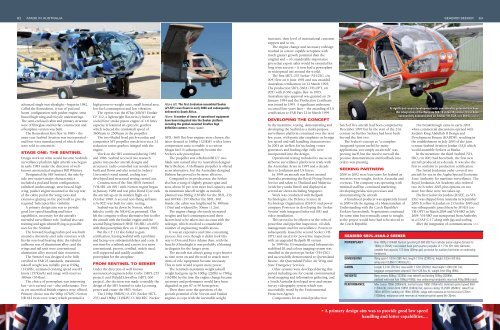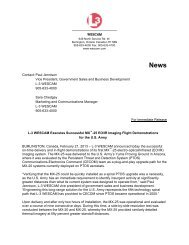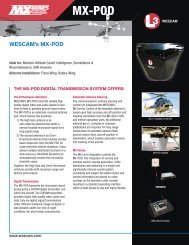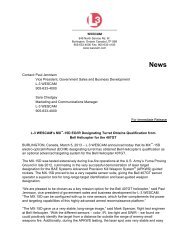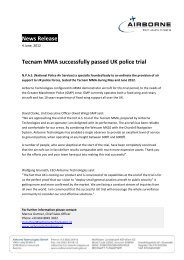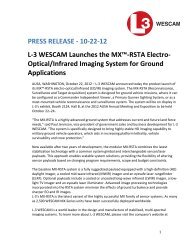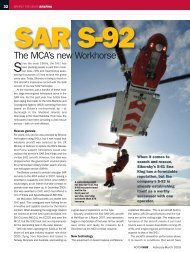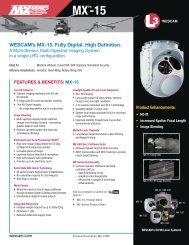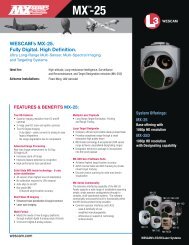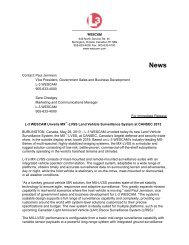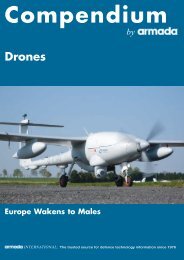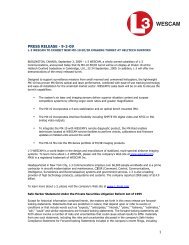Create successful ePaper yourself
Turn your PDF publications into a flip-book with our unique Google optimized e-Paper software.
62 MADE IN AUSTRALIASEABIRD SEEKER 63advanced single seat ultralight – began in 1982.Called the Rouseabout, it was of ‘pod andboom’ configuration with pusher engine, strutbraced high wing and tricycle undercarriage.The semi-enclosed cabin and primary structurewere of fibreglass and Kevlar construction anda floatplane version was built.The Rouseabout first flew in 1983 – thesame year Seabird Aviation was incorporated –and four were manufactured of which threewere sold to customers.STAGE ONE: THE SENTINELDesign work on what would become Seabird’ssurveillance platform light aircraft was begunin early 1985 under the direction of wellknownaeronautical engineer Bill Whitney.Designated the SB5 Sentinel, the side-bysidetwo-seater’s major characteristicsincluded a pod and boom configuration,tailwheel undercarriage, strut braced highwing, pusher engine mounted at the top rearof the cabin pod at the wing roots andextensive glazing on the pod itself to give therequired ‘helicopter-like’ visibility.A primary design aim was to providegood low speed handling and loitercapabilities, necessary for the aircraft’sintended surveillance role. Seabird also sawtraining and agricultural flying as possibleuses for the Sentinel.The forward fuselage/cabin pod was builtaround a chromoly steel tube structure withKevlar non-load bearing skin; the tubulartailboom was of aluminium alloy; and thewings and tail unit were conventionalaluminium alloy stressed skin structures.The Sentinel was designed to be fullycertified to FAR 23 standards, maximumtakeoff weight was initially put at 650kg(1430lb), estimated cruising speed was 85knots (157km/h) and range with reserves380nm (704km).The choice of powerplant was interestingbut – as it turned out – also unfortunate. Twoas yet uncertified British engines were offered.Primary choice was the 90hp (67kW) NortonNR 642 twin rotor rotary which promised ahigh power-to-weight ratio, small frontal area,low fuel consumption and low vibration.The option was the 87hp (65kW) EmdairCF 112, a lightweight flat-twin cylinder, aircooled four stroke piston engine of 1.8 litrescapacity. It featured an epicyclic gearboxwhich reduced the crankshaft speed of3600rpm to 2500rpm at the propeller.The two-bladed fixed pitch wooden andcomposites MT propeller was driven via a 3:1reduction ration gearbox integral with theengine.Work on the SB5 continued during 1985and 1986. Seabird received two researchgrants into pusher aircraft designs andstructures, radio controlled test models werebuilt and flown and also tested in SydneyUniversity’s wind tunnel, tooling wasdeveloped and structural testing carried out.Construction of the first SB5N Sentinel(VH-SBI, c/n 001) with Norton engine beganin January 1988 and test pilot David Eyre tookthe aircraft up on its maiden flight on 1October 1989. A second non-flying airframe(c/n 002) was built for static testing.Seabird was let down by Norton, whichfailed to certify the NR 642 as promised. Thisleft the company with no alternative but to offerthe aircraft with the Emdair engine and thesecond flying Sentinel (SB5E VH-SBU, c/n 003)with that powerplant flew on 11 January 1991.But the CF 112 also failed to gaincertification, leaving Seabird with a problemand facing very substantial delays and costs. Itwas time for a rethink and a move to a moreconventional, proven, certified, widely used,well supported and readily availablepowerplant for the aeroplane.FROM SENTINEL TO SEEKERUnder the direction of well knownaeronautical engineers John Corby (SB7L-235project) and Dafydd Llewellyn (SB7L-360project), the decision was made to modify thedesign of the SB5 Sentinel to take Lycomingpower and create the SB7L <strong>Seeker</strong>.The 116hp (88kW) O-235 (<strong>Seeker</strong> SB7L-235) and 180hp (119kW) O-360-B2C (<strong>Seeker</strong>Above left: The first Jordanian-assembled <strong>Seeker</strong>(JY-SE1) was flown in early 2006 and subsequentlydelivered to South Africa.Above: A number of items of operational equipmenthave been integrated into the <strong>Seeker</strong> platformincluding the gimbal-mounted Cineflex highdefinition camera. Photos: SeabirdSB7L-360) flat-four engines were chosen, thelatter derated to 168hp (125kW) with a lowercompression ratio to enable it to run onMogas fuel. It subsequently became the<strong>Seeker</strong>’s sole powerplant.The propeller was a Bishton BB177 twobladeunit named after its Australian designerBarry Bishton. A Hoffmann propeller is offeredas an alternative, but the Australian-designedBishton has proved to be more effective.Compared to its predecessor, the <strong>Seeker</strong>also has a wing of slightly greater span andarea, about 50 per cent more fuel capacity, andits maximum takeoff weight as initiallyplanned was 850kg (1874lb) for the SB7L-235and 897KG (1973lbs)for the SB7L-360.Inside, the cabin was lengthened by 380mm(15in) and widened by 30mm (1.2in).The engine change obviously increasedweights and fuel consumption and thesefactors had to be taken into account with theredesign, which involved a considerablenumber of engineering modifications.It was an expensive and time-consumingprocess, but even though it didn’t look thisway to Don and Peter Adams then, with thebenefit of hindsight it was probably a blessingin disguise for the longer term.The aircraft was always going to get heavieras time went on and the need to attach moreitems of role equipment became necessary.This in turn would require more power.The Sentinel’s maximum weight takeoffweight had gone up by 100kg (220lb) to 750kg(1653lb) by the time the engine change becamenecessary and performance would have beendegraded on just 87 or 90 horsepower.Then there were the questions of thegrowth potential of the Norton and Emdairengines to cope with the inevitable weightincreases, their level of international customersupport and so on.The engine change and necessary redesignresulted in a more capable aeroplane withmuch greater growth potential than theoriginal and – of considerable importancegiven that export sales would be essential forlong term success – it now had a powerplantin widespread use around the world.The first SB7L-235 <strong>Seeker</strong> (VH-ZIG, c/n004) flew on 6 June 1991 and was awardedAustralian certification on 12 March 1993.The production SB7L-360A (VH-OPT, c/n005) with 0-360 engine flew in 1993,Australian type approval was granted on 24January 1994 and the Production Certificatewas issued in 1995. A significant milestoneoccurred four years later – the awarding of UScertification to FAR Part 23 in March 1999.DEVELOPING THE CONCEPTIn the meantime, testing, demonstrating anddeveloping the Seabird as a multi-purposesurveillance platform continued over the nextfew years, with particular emphasis on benignlow speed and stall handling characteristics.In 2003 an ‘airflow kit’ including vortexgenerators and leading edge cuffs wereincorporated into the design.Operational testing included its use as anairborne surveillance platform in trials withthe Australian Army in 1995 and a decadelater to Jordanian and US forces.In 1994 an aircraft was flown aroundAustralia promoting the Royal Flying DoctorService and taken to Thailand and Malaysia(with ferry tanks fitted) and displayed atseveral air shows including Singapore.Work was conducted with RedpathTechnologies, the Defence Science &Technology Organisation (DSTO) and powercompany Powercor in developing the ‘<strong>Seeker</strong>System’ with integrated infra-red (IR) andvideo installation.This proved to be effective in the roles ofpowerline and pipeline inspection, oil slickmanagement and fire surveillance. Powercorsubsequently leased the second <strong>Seeker</strong> (VH-OPT) and used it for powerline inspectionswith an upgraded Redpath IR system.In 1999 the US-manufactured Inframetricsstabilised IR and colour imaging system wasinstalled in the prototype <strong>Seeker</strong> (VH-ZIG)and successfully demonstrated to QueenslandRescue, the Queensland Police Air Wing andState Emergency Services.Other systems were developed during thisperiod including one for coastal environmentaltrend mapping and information gathering, anda South Australia-developed river and streamsurvey videography system which wassuccessfully tested by the EnvironmentalProtection Agency.Components for an initial productionbatch of five aircraft had been completed byDecember 1997 but by the start of the 21stcentury no further <strong>Seeker</strong>s had been builtbeyond the first two.The <strong>Seeker</strong>’s concept as “a completeintegrated system useful for manyapplications, not simply an aircraft” wasproving itself, but the need to turn all thepositive demonstrations and feedback intoorders was pressing.SEEKING PARTNERS2000 to 2002 were lean years for Seabird asinvestors were sought, both in Australia andoverseas. The company was operating withminimal staff but continued marketing,developing production processes anddemonstrating the aircraft.A franchised producer was apparently foundin 2000 with the signing of a Memorandum ofUnderstanding with the Czech Republic’sEvektor-Aerotechnik. Negotiations continuedfor some time but eventually came to nought,as the project would have had to be moved tothe Czech Republic.SEABIRD SB7L-360A-2 SEEKERPOWERPLANTDIMENSIONSCABINWEIGHTSPERFORMANCEA significant recent development with considerable potential has beenthe integration of the <strong>Wescam</strong> MX-10 video/IR sensor. It has beensuccessfully demonstrated on <strong>Seeker</strong> VH-SUA (c/n 0010). SeabirdThe breakthrough came in early 2003when commercial discussions opened withJordan’s King Abdullah II Design andDevelopment Bureau (KADDB), resulting inthe establishment in July 2003 of the jointventure Seabird Aviation Jordan (SAJ) whichwould assemble <strong>Seeker</strong>s at Marka.In the meantime the third Seabird (VH-SBO, c/n 006) had been built, the first newaircraft produced in a decade. It was also thefirst to conform to production certification.The Initial Jordanian order covered twoaircraft for use in the Aqaba Special EconomicZone Authority for maritime surveillance. TheRoyal Jordanian Air Academy also orderedtwo in October 2003 plus options on twomore but these were not taken up.The first <strong>Seeker</strong> for Jordan (JY-SEE, ex-VH-ZIG) was shipped from Australia in September2003. It reflew in Jordan on 2 October 2003 andwas subsequently joined there by JY-SEA (ex-VH-OPT) in March 2004 and VH-SBO in July2004. VH-SBO was transported from Amberleyin a USAF C-17 along with jigs and tooling.After the integration of communications >>>One 180hp (134kW) Textron Lycoming O-360-B2C four-cylinder piston engine derated to168hp (125kW); two bladed fixed pitch pusher propeller of 1.77m (5ft 10in) diameter;useable fuel capacity 172 litres (38imp gal); provision for auxiliary fuel tanks on underwinghardpoints.Wing span 11.07m (36ft 4in); length 7.01m (23ft0 in); height 2.03m (6ft 8in);wing area 13.06m² (140.6sq ft.)Length 2.21m (7ft 3in); max width 1.12m (3ft 8in); max height 1.09m (3ft 7in);baggage compartment volume 0.75m³ (26.5cu ft), weight limit 45kg (99lb).Basic empty 604kg (1332lb); max takeoff and landing 925kg (2039lb);payload with max fuel 189kg (416lb); two underwing hardpoints max load 40kg (88lb) each.Max cruise 108kt (200km/h); normal cruise 100kt (185km/h); minimum patrol speed 65kt(120km/h); initial climb 1085ft (330m)/min; service ceiling 15,250ft (4648m); takeoff run265m (870 ft); landing roll 199m (655ft); range with reserves at normal cruise 570nm(1056km); endurance with reserves at minimum patrol speed 6hr 30min.• A primary design aim was to provide good low speedhandling and loiter capabilities....


